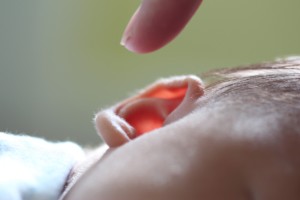 Frequent ear infections often go hand in hand with the development of speech and language. When it comes to childhood aliments, ear infections are one of the most common. In fact, about 75% of children under the age of 3 have been affected by at least one ear infection. With half of these children suffer with three or more infections.
Frequent ear infections often go hand in hand with the development of speech and language. When it comes to childhood aliments, ear infections are one of the most common. In fact, about 75% of children under the age of 3 have been affected by at least one ear infection. With half of these children suffer with three or more infections.
ASHA explains why ear infections are so common with children. “The eustachian tube, a passage between the middle ear and the back of the throat, is smaller and more nearly horizontal in children than in adults. Therefore, it can be more easily blocked by conditions such as large adenoids and infections. Until the eustachian tube changes in size and angle as the child grows, children are more susceptible to otitis media.”
When a child has ear infections over and over, the bones in the ear, nerves, and the eardrum can be damaged, causing hearing loss. Since children learn their speech and language skill by listening to people talk, any type of hearing loss can influence their development.
Toddlers and school age children can develop hearing loss. Healthy Hearing list some signs to look for:
Has difficulty understanding what people are saying.
Speaks differently than other children her or his age.
Doesn’t reply when you call his or her name.
Responds inappropriately to questions (misunderstands).
Turns up the TV volume incredibly high or sits very close to the TV to hear.
Has problems academically, especially if they weren’t present before.
Has speech or language delays or problems articulating things.
Watches others in order to imitate their actions, at home or in school.
Complains of ear pain, earaches or noises.
Cannot understand over the phone or switches ears frequently while talking on the phone.
Says “what?” or “huh?” several times a day.
Watches a speaker’s face very intently—many children’s hearing loss escapes detection because they are very successful lip readers
 If you have any concerns about your child’s ability to speak, hear, or understand, don’t delay. Treated early enough, some disorders can be prevented or even reversed
If you have any concerns about your child’s ability to speak, hear, or understand, don’t delay. Treated early enough, some disorders can be prevented or even reversed
The first step is getting evaluated by a pediatric speech-language therapist to determine the need for speech, language, and occupational needs. A therapist will listen to your child, observe how they move their tongue, jaw, and lips.
Depending on the age, test their language skills. For instance, listen to them tell a story or see how well they follow directions.
If you suspect your child has a speech -language disorder, early intervention makes all the difference. At First Words Speech Therapy we are dedicated to meeting your child’s speech and language disorder with personalized care. As a mobile service, we are able to render therapy in your child’s natural environment.


